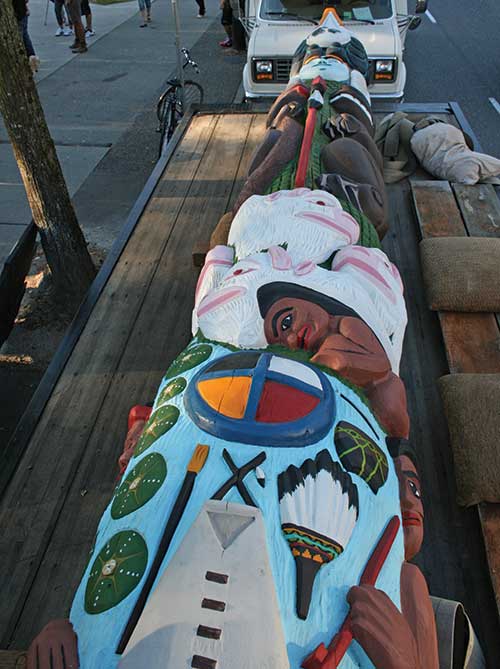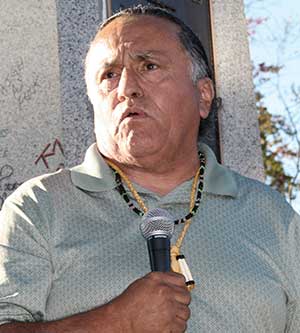Travelling totem tells Coast Salish message
On a warm August evening in Vancouver’s Grandview Park, about 200 people have gathered around a Coast Salish totem pole.
The pole, strapped to the back of a truck, is making its first stop on an 8,000 km journey around Turtle Island, an Indigenous name for North America.
Its creator, master Lummi Nation carver Jewell James, is leading the trek and he is being joined by a crew from Lummi near Bellingham, WA.
The goal of the journey is to unite Indigenous communities across the continent that are fighting fossil fuel projects – from oil pipelines and tankers to mining. Lummi Nation itself successfully blocked a coal export facility from being built in its territory last year.
James said nations from both Canada and the United States must hold government accountable. “We’re not supposed to be this greedy,” he said. “If [leaders] turn a deaf ear to our concerns about the environment, about the quality of the air, the water, the land, or even the health of our children, then it’s time to ask them to step down.”
When the group from Lummi stopped in Vancouver, it was supporting Tsleil-Waututh Nation’s fight against the proposed Kinder Morgan pipeline expansion project.
Over the next several weeks, the crew went on to stop in numerous American and Canadian cities and communities, including Seattle, Longview and Missoula.
They made a special stop in Standing Rock Sioux reservation in North Dakota where an occupation was taking place in protest of the Dakota Access oil pipeline.
The journey culminated in a stop in Winnipeg, where Lummi stood with the city’s Indigenous community in rejection of the proposed Energy East oil pipeline.
James explained that the pole itself – made of red cedar and standing close to seven metres tall – will send blessings and protection to the communities it touches down on through a number of symbols.
“On the top there is an eagle. A leader that’s like an eagle can see all of this, can see all that destruction and report to the people,” he said. “We’ve got a face on it representing father sky, we’ve got the moon on the eagle’s chest.”
James said that there’s a wolf on the pole, because wolves go out and scout and tell the people what’s happening.
There’s also a bear, because, he said, Indigenous people must have the endurance and strength of a bear. Other symbols include four sacred buffalo, a warrior and pipe carrier.
It’s the latest in a series of totem pole journeys that have been organized by Lummi over several decades. The first poles were carved after the 9/11 attacks and sent to Washington and New York.
Another was carved to protect Tsleil-Waututh Nation’s territory and it sits on its reserve in North Vancouver looking out at the Kinder Morgan oil terminal.
James later connected it to a second pole on the other side of the pipeline in Beaver Lake Cree Nation northeast of Edmonton.
Eugene Kung, a lawyer who works with Tsleil-Waututh’s anti-pipeline organization the Sacred Trust, said the poles are special because they’re a representation of Indigenous law and have brought communities together.
“It was Jewell’s generosity and spirit of unity that brought together all of these fights: coal exports, oil pipelines and tankers…” he said.
Rueben George of the Sacred Trust added that he sees something special happening among First Nations that he hopes will spread to the rest of Canada.
“What’s happening is the Indigenous people are uniting,” he said. “What’s beautiful and what blows me away… is that these nations are saying ‘No’. They’re saying no even though people are suffering and that money would help my people out of poverty.”
Before the pole moved on from Vancouver, numerous people placed their hands on it and prayed.
James expressed his gratitude to have the opportunity to visit his Coast Salish relatives in BC. “These are all our relatives,” he said, referring to the Coast Salish communities around the Salish Sea.
“All of us coming together have a great amount of power… The totem pole journey is about going to the communities and saying ‘We hear you.’
“That’s what we’re demanding. Stand up, work together, cooperate.”
Story and photos by Cara McKenna





